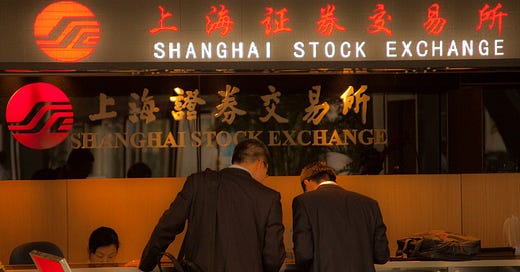Emerging Markets Daily - January 25
China: Asia's Great Hope for Stocks?, IMF Warns on Global Recovery, Has the India Bull Run Ended?, EM Braces for Fed Hike Impact, OPEC+ Slows Production Increases
The Top 5 Stories Shaping Emerging Markets from Global Media - January 25
As Fed Hikes Loom, China Emerges as Asia Hope for Stocks
“Jefferies Financial Group Inc. and Deutsche Bank AG have just joined Goldman Sachs Group Inc. and HSBC Holdings Plc in turning bullish on China equities.”
Bloomberg
“It wasn’t long ago that investors blamed China’s performance for the poor showing of Asian stocks versus global peers. Now a potential rebound in the nation’s equities is boosting optimism for the whole region to do better in 2022.”
“While imminent rate hikes from the Federal Reserve hammer shares around the world, a shift to monetary support by the People’s Bank of China is seen boosting markets in Hong Kong and on the mainland. Jefferies Financial Group Inc. and Deutsche Bank AG have just joined Goldman Sachs Group Inc. and HSBC Holdings Plc in turning bullish on China equities.”
“‘Rates are being lowered in China and earnings growth in Asia looks to be on a reasonable footing,’ said Herald van der Linde, Asia-Pacific head of equity strategy at HSBC. ‘This sets Asia up for good performance from hereon. We see more and more funds looking at Chinese equities.’”
“The Hang Seng China Enterprises Index and the Hang Seng Index have already climbed about 4% each this year, leading gains in Asia. That’s even as concerns about Beijing’s crackdown on private enterprise remain and China’s property sector struggles with defaults. They were the world’s worst performers in 2021, with the HSCEI gauge losing almost a fourth of its value.”
“Investors are pinning hopes that gains in China and Hong Kong stocks -- which make up a quarter of the MSCI Asia Pacific Index -- will help the regional gauge bounce back. It trailed the MSCI AC World Index by 20 percentage points last year but has fallen less than equity benchmarks for the U.S. and Europe so far in 2022 amid a global selloff.”
‘The emphasis should switch from U.S./Europe to Asia/China,’ said Tai Hui, chief Asia market strategist at JPMorgan Asset Management. Shikhar Balwani reports.
IMF Warns of ‘Multiple Challenges’ to Global Economic Recovery
“The IMF’s forecast for the global economy is for growth in gross domestic product to slow from 5.9 per cent in 2021 to 4.4 per cent this year, weakening further in 2023 to only 3.8 per cent.”
Financial Times
”The global economic recovery from coronavirus will run into ‘multiple challenges’ this year, the IMF said on Tuesday, warning of lower growth and higher inflation.”
“Significantly downgrading its 2022 forecasts for economic activity in the world’s two largest economies, China and the US, the updated economic forecasts from the fund show it becoming more pessimistic about the scope for a full recovery from the pandemic.”
“The outlook would be even worse, the IMF added, if central banks have to take firmer action to quell inflation or geopolitical tensions in Ukraine intensify. The IMF’s forecast for the global economy is for growth in gross domestic product to slow from 5.9 per cent in 2021 to 4.4 per cent this year, weakening further in 2023 to only 3.8 per cent.”
“The fund has knocked 0.5 percentage points off its growth forecast for 2022 with only a modest bounce back of 0.2 percentage points for 2023. Gita Gopinath, the IMF’s first deputy managing director, said in a blog post that the world economy was grappling with supply disruptions, higher inflation, record debt and uncertainty.”
“‘The continuing global recovery faces multiple challenges as the pandemic enters its third year,’ she said. ‘The last two years reaffirm that this crisis and the ongoing recovery is like no other,’ Gopinath added.”
“…For China, the fund downgraded the 2022 growth outlook from 5.6 per cent to 4.8 per cent on the back of the restrictions needed to continue with its zero-Covid policy and the retrenchment in the property sector. But Gopinath did not think a Chinese slowdown stemming from its property sector would derail the global economy.”
“For almost all of the world, inflation is now expected to be higher this year, requiring central banks to tighten monetary policy and putting pressure on countries to make sure their levels of borrowing come down as the cost of credit rises. This will put most pressure on emerging and developing economies, the fund said, adding to concerns raised earlier this year by the World Bank. Those with large amounts of foreign currency-denominated debt will be most at risk.” The FT reports.
Has the Bull Market Ended for the Indian Stock Market?
Quartz India
“The year 2022 has begun badly for the Indian stock market.”
“Over the past five trading sessions, key domestic indices Sensex and Nifty50 have both plunged by over 6% due to losses in financial and technology stocks. ‘The trend in global stock markets has turned distinctly bearish. Last week, S&P 500 and Nasdaq closed 8% and 15% below their all-time highs,’ said VK Vijayakumar, chief investment strategist at brokerage firm Geojit Financial Services. ‘…the bulk of the selling is happening in non-profitable tech stocks. This trend is impacting stocks like Zomato and Paytm in India, too.’”
“Shares of technology startups like Paytm, PolicyBazaar, Nykaa, Zomato, and CarTrade Tech, which hit the bourses last year, are now trading at a 20%-50% discount to their issue price. The major concern for markets currently is inflation and the anticipated rate hike by the US Federal Reserve in a couple of days.”
“Indian shares mirrored the decline in global stocks largely due to a rise in bond yields amid growing expectations that the US central bank will raise key interest rates.”
“Higher US yields and interest rate hikes tend to make investments in equities in emerging markets like India less attractive, leading to an outflow of foreign funds. This is why foreign portfolio investors (FPIs) have begun reorienting to less-risky assets like gold.” Quartz India reports.
As Fed Prepares to Hike, Emerging Markets Brace for Impact
Al Jazeera
“If there were a character in literature who best mirrored the power the United States Federal Reserve wields over the global economy, it would be Gulliver. Though he was a decent chap who meant no harm, his very massiveness presented a danger to all around him – in this case, the Lilliputians of the global economy: emerging markets (EMs).”
“But unlike Gulliver, the Fed is constitutionally prohibited from heeding the cries of Lilliputian economies when crafting interest rate policy. The Fed’s dual remit is narrow and decidedly parochial: Use monetary policy to battle US inflation and maximise the US job market. Preventing chaos in emerging markets simply does not come into it.”
“Yet some EM chaos may beckon. On Tuesday, Federal Reserve policymakers will kick off their first two-day meeting of this year. As 2021 drew to a close, the Fed pivoted priorities away from supporting jobs creation by keeping borrowing costs low and towards reining in inflation – which is running near a 40-year high.”
“To achieve that, it signalled that it is gearing up for at least three hikes to its benchmark interest rates this year…”
“When the Fed hikes interest rates, borrowing becomes costlier throughout the world. That is especially true of countries that have so-called ‘dollarized debt’ – nations that have taken advantage of the decade-plus of low interest rates by issuing sovereign bonds denominated in dollars, and that now face the prospect of refinancing those bonds in much less favourable conditions.”
“…HSBC, for its part, has been monitoring what it calls the ‘fragile four’ – Indonesia, Brazil, Mexico and South Africa – out of concern that their high dollar-debt levels may make them particularly vulnerable to higher US interest rates. Analysts worry, too, about Turkey, where debt is spiking and a series of interest rate cuts last year in the face of soaring inflation – an unorthodox policy championed by President Recep Tayyip Erdogan – led the Turkish lira to crash.”
“…The markets continue to see the Fed’s March meeting as the most likely start of the rate increases, as the Omicron variant of the coronavirus once again reminds global markets that there’s more than one invisible hand at play. By then, US inflation may have abated somewhat and a clearer trajectory of both US and global growth may have emerged, negating the need for sudden steep hikes that would almost certainly bring instability to emerging markets.” Michael Moran writes.
OPEC+ Increases Fall Short of Promises, Stoking Price Rises
Wall Street Journal
“OPEC and its Russia-led partners have promised to increase oil production to pre-pandemic levels this year but are falling short of those public commitments, stoking fast-rising global crude markets.
“Last month, the Organization of the Petroleum Exporting Countries and its Russia-led allies increased their collective production by 250,000 barrels a day, or 60% of what the two groups promised for the month, according to the International Energy Agency. Overall, the group is pumping 790,000 barrels a day below its publicly stated targets, said the Paris-based watchdog, which advises industrialized nations on energy.”
“The shortfalls have softened the market effect of a series of steady increases in oil output that the two groups, known together as OPEC+, have announced in recent months: Instead of curbing prices, the group’s inability to increase as promised has become a reason for traders to bet on higher prices.”
“‘These monthly [OPEC] additions are increasingly nominal,’ said Bill Farren-Price, director of intelligence at London consulting firm Enverus. ‘They are not fully backed by real barrels.’ One factor in pushing prices higher is ‘the concern that OPEC has very little scope to make up for any supply disruptions elsewhere,’ he said.” WSJ reports.
“If you have no confidence in self, you are twice defeated in the race of life. With confidence, you have won even before you have started.” - Marcus Tullius Cicero






